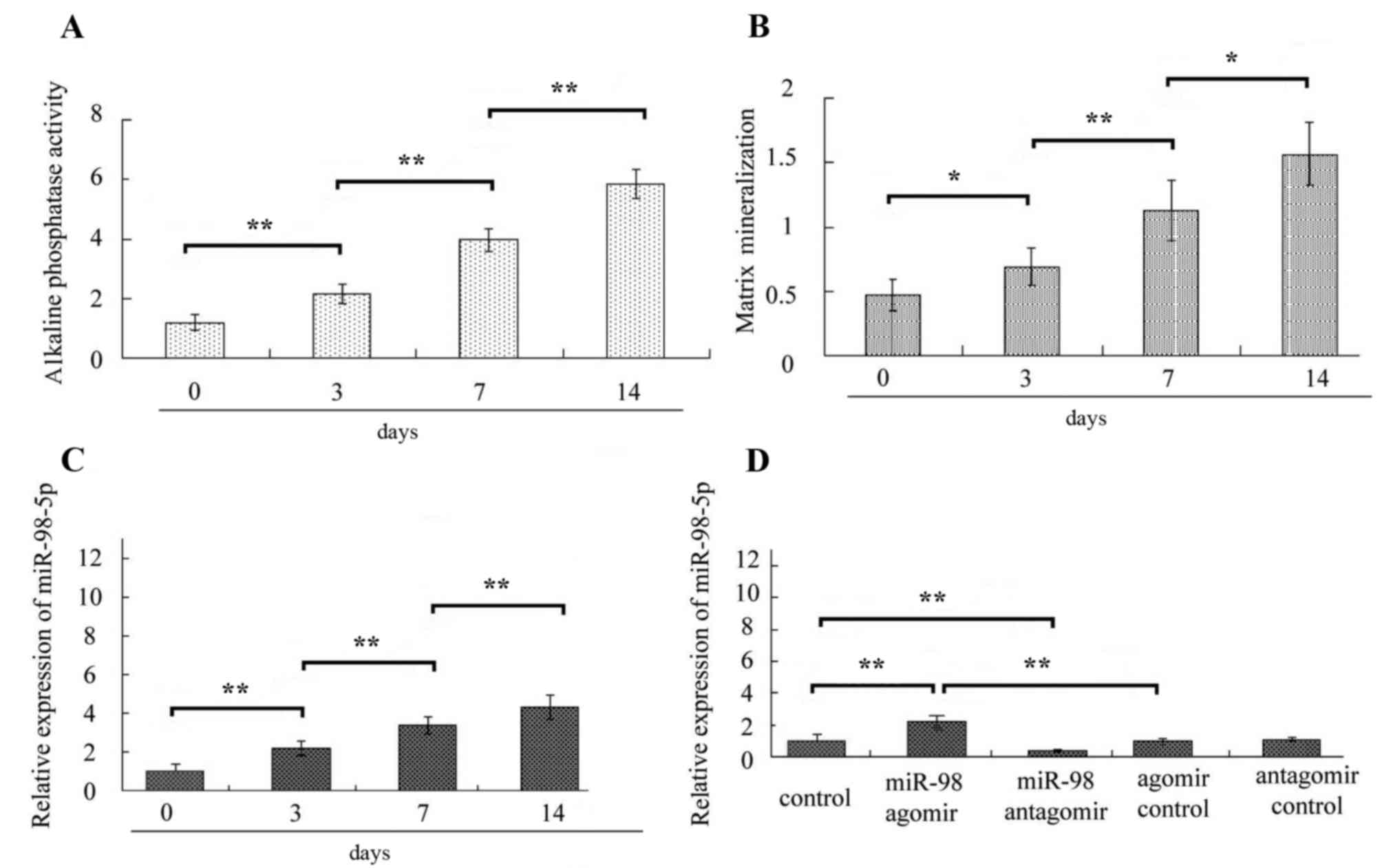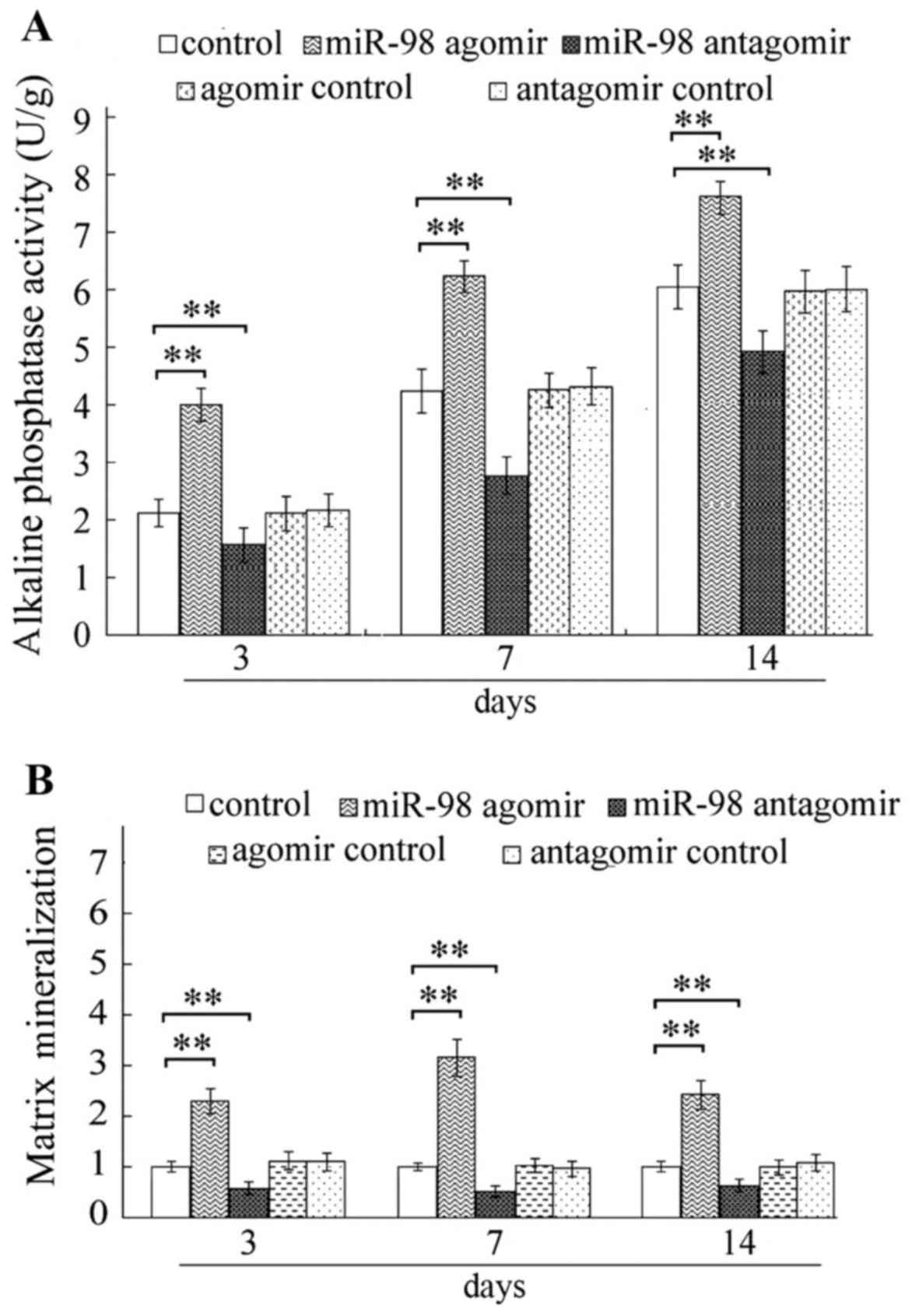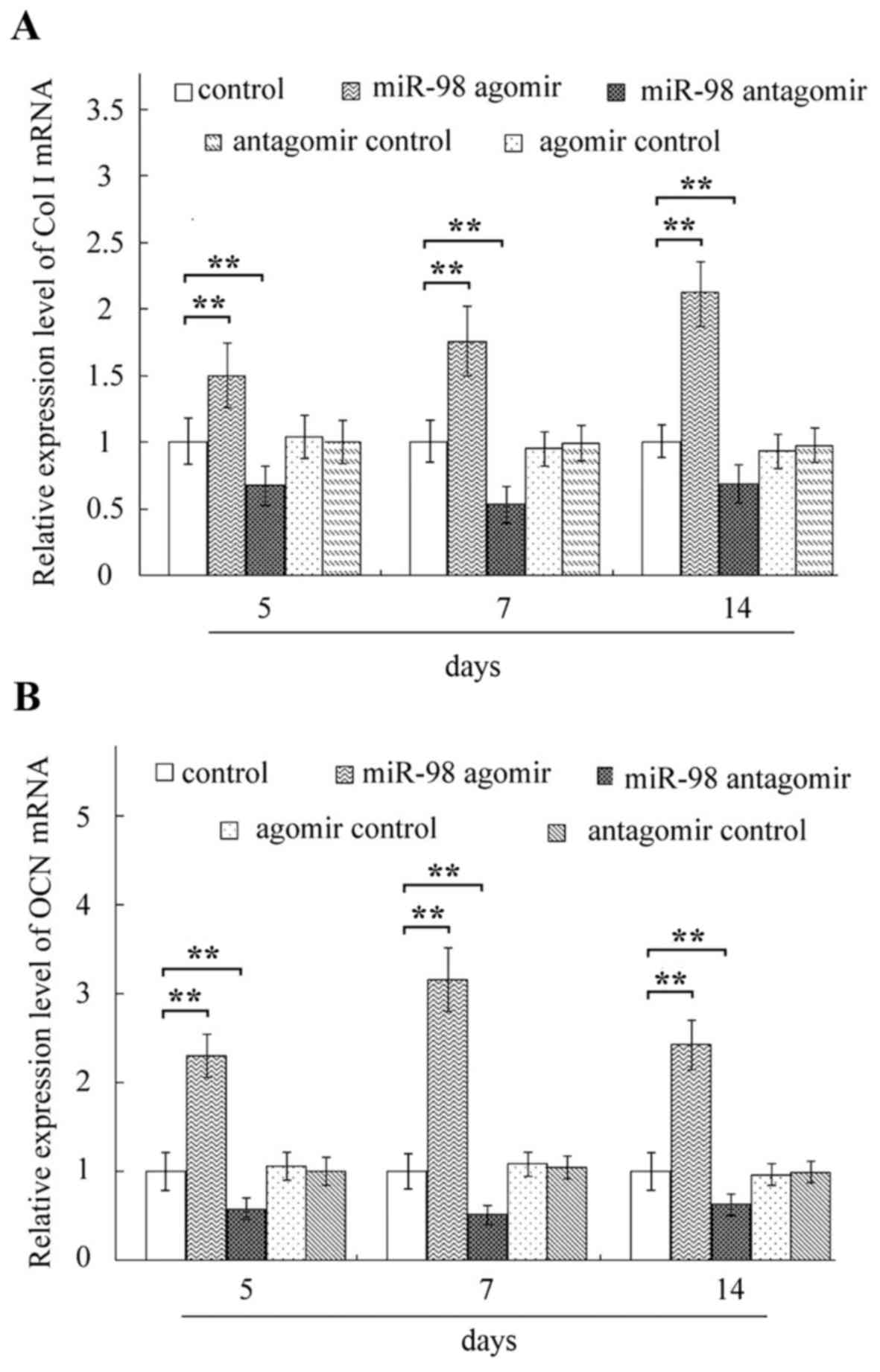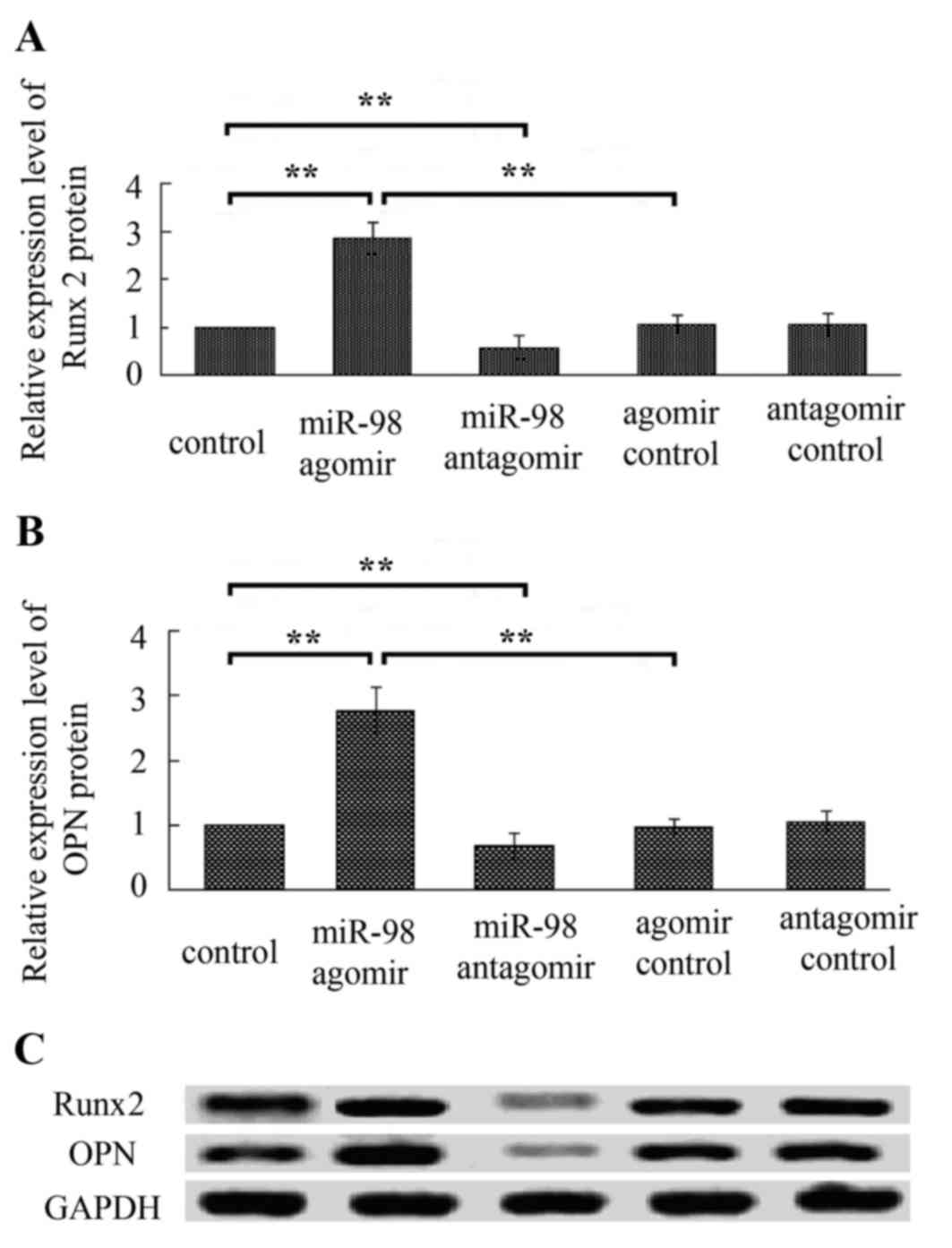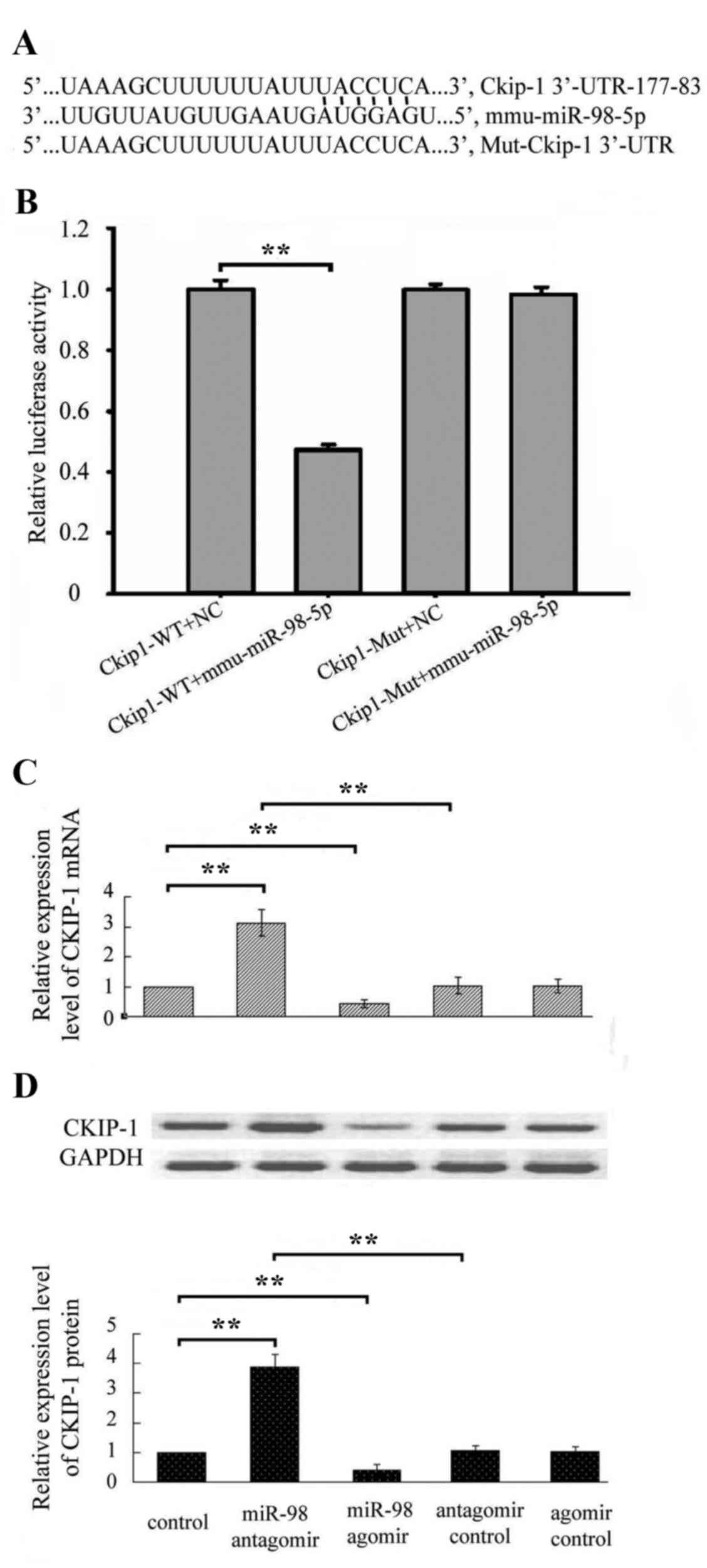miR‑98‑5p promotes osteoblast differentiation in MC3T3‑E1 cells by targeting CKIP‑1
- Authors:
- Published online on: January 9, 2018 https://doi.org/10.3892/mmr.2018.8416
- Pages: 4797-4802
Abstract
Introduction
Osteoblasts are the differentiated cell types responsible for bone formation, originating from resident bone marrow-derived mesenchymal stem cells (BMSCs) or bone marrow stromal cells (1,2). Regulation of osteoblast differentiation and activity has been hypothesized as a prospective therapy of bone injury and loss. In order to develop such therapies, novel molecular targets that regulate osteoblast differentiation and activity need to be identified.
Casein kinase 2-interacting protein 1 (CKIP-1) is a negative regulator for bone formation under physiological conditions. In CKIP-1 knockout mice, bone mineral density and mass increased markedly, as did the activity of osteoblasts (3). CKIP-1 interacts with mothers against decapentaplegic homolog ubiquitination regulatory factor 1 to induce negative regulation in bone formation (4). In addition, as a result of inhibition of CKIP-1 expression in osteoblasts, bone mass increased markedly and the rate of bone formation accelerated (5,6).
MicroRNAs (miRs), classified as small noncoding RNAs, regulate gene expression by targeting the 3′-untranslated region (UTR) of mRNA (7,8). MiRs serve a role in cell development and growth processes, including cell proliferation, apoptosis and differentiation (9,10). Previous studies have identified miRNAs that regulate osteoblast differentiation (11,12). CKIP-1 is a negative regulator for osteoblast differentiation and therefore, an miR targeting CKIP-1 may improve osteoblast differentiation.
The authors of the present study previously demonstrated that CKIP-1 is a putative target gene of miR-98-5p using bioinformatics analysis (unpublished data). It has been hypothesized that miR-98-5p may be involved in osteoblast differentiation through regulation of CKIP-1 expression. In the present study, mouse MC3T3-E1 pre-osteoblasts were used to investigate the potential role and underlying mechanism of miR-98-5p-mediated regulation of osteoblast differentiation.
Materials and methods
Cell culture
Mouse pre-osteoblast cell line, MC3T3-E1 (Institute of Basic Medicine of Peking Union Medical College, Beijing, China), was cultured with α-minimal essential medium (α-MEM; Invitrogen; Thermo Fisher Scientific, Inc., Waltham, MA, USA) supplemented with 10% fetal bovine serum (FBS; Thermo Fisher Scientific, Inc., Waltham, MA, USA) and 1% penicillin (Thermo Fisher Scientific, Inc.) at 37°C in a humidified atmosphere containing 5% CO2. For all experiments, MC3T3-E1 cells were seeded at the density of 2.5×104 cells/cm2 in cell culture dishes and cultivated until 80% confluence was reached. To induce osteoblast differentiation, confluent cells were cultured at 37°C in a humidified atmosphere containing 5% CO2, in an osteoinductive medium supplemented with 10% FBS, 50 µg/ml ascorbic acid, 5 mM sodium b-glycerophosphate and 2 mM/l glutamine, which was replaced once every three days (13).
Reverse transcription-quantitative polymerase chain reaction (RT-qPCR)
Cultured cells were lysed by TRIzol® reagent (Invitrogen; Thermo Fisher Scientific, Inc.) and total RNA was isolated according to the manufacturer's protocol. cDNA was synthesized using the TIANScript II RT kit (Tiangen Biotech Co., Ltd., Beijing, China). For miRNA expression analysis, cDNA synthesis was performed using the TaqMan MicroRNA reverse transcription kit (Applied Biosystems; Thermo Fisher Scientific, Inc.). qPCR was performed to detect mRNA levels of osteocalcin (OCN), collagen type I (Col I) and GAPDH or miR-98-5p levels using SYBR Green I PCR Mix (Beijing CoWin Biotech Co., Ltd., Beijing, China) according to the manufacturer's protocol. Primer sequences are listed in Table I and the primers for miR-98-5p (miRBase accession no. MIMAT0000545) were provided by Guangzhou RiboBio Co., Ltd. (Guangzhou, China). The following thermocycling conditions were used for the PCR: Initial denaturation at 94°C for 180 sec; 40 cycles of 94°C for 15 sec, annealing at 60°C for 30 sec, and extension at 72°C for 30 sec. Relative expression was normalized to mRNA levels of GAPDH using the 2−ΔΔCq method (14).
Detection of osteoblast differentiation
To investigate the role of miR-98-5p expression on osteoblast differentiation, confluent MC3T3-E1 cells were pre-treated with 100 nM miR-98-5p agomir, antagomir, agomir control or antagomir control (Guangzhou RiboBio Co., Ltd.) for 24 h at 37°C in α-MEM culture medium. Control MC3T3-E1 cells were cultured in α-MEM culture medium only, without pre-treatment. Cells were subsequently cultured in osteoinductive medium for 3, 5, 7 and 14 days, as described above. Cells were harvested, washed with a PBS and lysed with a lysis buffer (10 mmol/l 4-(2-hydroxyethyl)-1-piperazineethanesulfonic acid, 250 mmol/l sucrose, 5 mmol/l Tris-HCl, 0.1%TritonX-100, pH 7.5). Alkaline phosphatase (ALP) activity of lysates was measured using the ALP Activity Assay kit (Nanjing Jiancheng Bioengineering Institute, Nanjing, China) at 25°C using the p-nitrophenyl phosphate method according to manufacturer's protocol. Matrix mineralization was detected with Alizarin red S staining. Briefly, cells were fixed with 70% ethanol for 30 min at room temperature and washed with PBS. Subsequently, cells were stained with Alizarin red S solution (40 mM) for 15 min at room temperature. Excessive stain was washed off with PBS. Alizarin red S-stained mineral deposits were extracted and dissolved in 0.1 N NaOH and the absorbance was measured at a wavelength of 540 nm using an ELISA reader (Multiskan GO 1510; Thermo Fisher Scientific, Inc.).
Western blot analysis
Following washing twice with PBS, cells were lysed in ice-cold radioimmunoprecipitation assay lysis buffer (Beyotime Institute of Biotechnology, Nanjing, China). Protein concentration was quantified using bicinchoninic acid method. Equal amounts of protein (20 µg/lane) were separated on 10% SDS-PAGE and transferred onto polyvinylidene difluoride (PVDF) membranes (EMD Millipore, Billerica, MA, USA). PVDF membranes were blocked with 3% skimmed milk for 1 h at 37°C and incubated overnight at 4°C with the following primary antibodies: Anti-CKIP-1 (cat. no. sc-376355; 1:500), anti-runt-related transcription factor 2 (Runx 2; cat. no. sc-390351; 1:500), anti-osteopontin (OPN; cat. no. sc-21742; 1:500) and anti-GAPDH (cat. no. sc-59540; 1:1,000), all purchased from Santa Cruz Biotechnology, Inc. (Dallas, TX, USA) at 4°C. Membranes were washed with PBS with Tween-20 (PBST) and incubated with horseradish peroxidase conjugated secondary antibodies (cat. no. sc-2371; 1:2,000, BIOSS, Beijing, China) for 1 h at room temperature. Following washing with PBST, bands were detected with an enhanced chemiluminescence reagent (Wuhan Boster Biological Technology, Ltd., Wuhan, China). Band intensities were quantified using Image-Pro Plus software (version 6.0; Media Cybernetics, Inc., Rockville, MD, USA). The data were presented following normalization with the control group.
Target prediction of miR-98-5p
The target mRNA of miR-98-5p was predicted by searching the online databases TargetScan (http://www.targetscan.org/) and miRDB (http://www.mirdb.org/). mRNAs with a 3′-untranslated region (3′-UTR) that matched the 2–7 base of the miR-98-5p 5′-terminal region with high thermodynamic stability were selected. Subsequently, CKIP-1 was predicted as a target mRNA of miR-98-5p.
Dual-luciferase reporter assay
The 3′-UTR region of CKIP-1, containing the binding site of miR-98-5p, was amplified and subcloned into a pmiR-RB-REPORT plasmid (Guangzhou RiboBio Co., Ltd., Guangzhou, China), according to the manufacturer's protocol. The corresponding mutated 3′UTR of CKIP-1 was also amplified and subcloned into the plasmid. Human 293 cells (the 293 cells in the present study were only used for the luciferase assay) were seeded into 6-well cell culture plates at 1×105 cells/well and subsequently transfected with miR-98-5p mimics (sequence, UGAGGUAGUAAGUUGUAUUGUU) or miR-98NC (sequence, UCACAACCUCCUAGAAAGAGUAGA; Guangzhou RiboBio Co., Ltd.) at a final concentration of 50 nM for 24 h. Subsequently, the pmiR-RB CKIP-1 3′-UTR plasmid was transfected into 293 cells at concentration of 1 ng/µl using a Lipofectamine® 2000 transfection reagent (Invitrogen; Thermo Fisher Scientific, Inc.) according to the manufacturer's protocol. A total of 2 days following transfection, the luciferase activity of the cells was determined using a dual-luciferase reporter assay kit (Promega Corporation, Madison, WI, USA) and was normalized to Renilla luciferase activity, according to the manufacturer's protocol.
Statistical analysis
All data are presented as the mean ± standard deviation from three separate experiments (n=3). Data was tested for normal distribution using Shapiro-Wild test and differences between groups were analyzed using one-way analysis of variance and determined by Duncan's multiple range test. Statistical analysis was performed using SPSS software (version 18; SPSS, Inc., Chicago, IL, USA). P<0.05 was considered to indicate a statistically significant difference.
Results
MiR-98-5p promotes osteoblast differentiation
In order to determine whether miR-98-5p is involved in regulation of osteoblast differentiation, the expression of miR-98-5p in MC3T3-E1 cells following osteoblast differentiation was detected by RT-qPCR. In the present study, following culture of MC3T3-E1 cells in osteoinductive medium, alkaline phosphatase activity and matrix mineralization of cells was elevated at each time point (Fig. 1A and B), indicating that MC3T3-E1 cells differentiated into osteoblasts. The expression level of miR-98-5a was also significantly elevated at each time point following osteoblast differentiation (all P<0.01; Fig. 1C), which suggested that miR-98-5p may serve a role in osteoblast differentiation.
To confirm the role of miR-98-5p in the regulation of osteoblast differentiation, MC3T3-E1 cells were treated with miR-98-5p agomir or miR-98-5p antagomir and the treatments increased and decreased the miR-98-5p expressions levels in MC3T3-E1 cells, respectively (Fig. 1D). Furthermore, the present study demonstrated that miR-98-5p agomir markedly increased ALP activity (Fig. 2A) and matrix mineralization (Fig. 2B), at each time point compared with the respective control groups. Elevated mRNA expressions of Col I and OCN (Fig. 3), and increased protein levels of Runx2 and OPN (Fig. 4) were observed in cells following treatment with miR-98-5p, at each time point compared with the respective control groups. Conversely, miR-98-5p antagomir significantly inhibited ALP activity and matrix mineralization, and decreased expression levels of OCN, Col I, Runx2 and OPN (Figs. 2–4).
CKIP-1 is a target gene of miR-98-5p
Subsequently, the expression of the target gene of miR-98-5p that contributed to the regulation of osteoblast differentiation was investigated and CKIP-1. To validate the interaction between miR-98-5p and CKIP-1, a dual-luciferase reporter assay was performed in the present study. The results demonstrated that overexpression of miR-98-5p significantly decreased the luciferase activity in cells transfected with pmiR-RB CKIP-1 3′-UTR, whereas it demonstrated no effect on pmiR-RB-mut CKIP-1 3′-UTR (Fig. 5B).
Following treatment with miR-98-5p agomir or miR-98-5p antagomir, qPCR and western blot analysis demonstrated that miR-98-5p overexpression decreased mRNA and protein levels of CKIP-1, whereas inhibition of miR-98-5p increased mRNA and protein expression of CKIP-1 (Fig. 5C). The aforementioned results indicate that CKIP-1 is the target gene of miR-98-5p.
miR-98-5p regulates osteoblast differentiation by targeting CKIP-1
The present study investigated the mechanism underlying miR-98-5p-mediated regulation of osteoblast differentiation. The association between overexpression and inhibition of miR-98-5p and osteoblast differentiation was investigated. In the present study, following treatment with miR-98-5p agomir, osteoblast differentiation-associated markers, including ALP, matrix mineralization, OCN, Col I, Runx2 and OPN were markedly elevated in MC3T3-E1 cells (Figs. 2–4). Conversely, treatment with miR-98-5p antagomir decreased the levels of osteoblast differentiation-associated markers (Figs. 2–4).
Discussion
ALP, OPN, Runx 2, OCN and matrix mineralization are markers of osteogenic differentiation and therefore they have been previously assayed to evaluate osteoblast differentiation (15–19). Col I, a collagen identified in bone matrices, is also a maker of osteogenesis (20). Therefore, in the present study, ALP, OPN, Runx 2, OCN, Col I and matrix mineralization were selected as indices of osteoblast differentiation.
In the present study, miR-98-5p served the role of regulator of osteoblast differentiation by downregulating the expression of CKIP-1, a negative regulator of osteoblast differentiation. The results of the present study indicated that the expression of miR-98-5p was increased during osteoblast differentiation and miR-98-5p overexpression significantly promoted osteoblast differentiation of MC3T3-E1 cells. Downregulated expression of miR-98-5p negatively regulated osteoblast differentiation. Using a dual-luciferase reporter assay, a direct interaction between miR-98-5p and the 3′-UTR region of CKIP-1 was verified. In the present study, miR-98-5p negatively regulated mRNA and protein expression levels of CKIP-1 in MC3T3-E1 cells. Transfection with miR-98-5p agomir or antagomir disrupted the interaction between CKIP-1 and osteoblast differentiation. The present study demonstrated that miR-98-5p regulates CKIP-1 expression.
The role of miR-98 in different cellular processes in various cell types has been previously investigated. miR-98 repressed the expression of cytokine-inducible Src homology 2-containing protein in cholangiocytes and was involved in responses to microbial challenge and inflammation (21). MiR-98 also negatively regulated interleukin-10 production and endotoxin tolerance in macrophages following stimulation with lipopolysaccharide (22). miR-98 is a tumor suppressive miRNA, knockdown of which leads to a reduction of 1,25-vitamin D anti-growth effect of prostate cancer and overexpression of miR-98 suppressed prostate cancer cell growth (23). miR-98 inhibits human ovarian cancer stem cell proliferation via retinoblastoma-associated protein-E2F transcription factor pathway and suppresses hepatocellular carcinoma by targeting Sal-like protein 4 and collagen triple helix repeat containing 1 (24–26). Currently, a limited amount of data is available regarding miR-98-mediated regulation of osteoblast differentiation.
In the present study, miR-98-5p was involved in the regulation of osteoblast differentiation through targeting and regulating CKIP-1 expression. The results of the present study indicated that CKIP-1 was a target gene of miR-98-5p, through which miR-98-5p regulated osteoblast differentiation in MC3T3-E1 cells.
CKIP-1 regulates a number of processes, including cell proliferation, differentiation and apoptosis. CKIP-1 also serves a role in numerous types of cancer, including colon and breast cancers, and human osteosarcoma. Knockdown of CKIP-1 promotes proliferation of NHL cells by altering the interaction with RAC-alpha serine/threonine-protein kinase (Akt) (27). CKIP-1 inhibits macrophage proliferation through activation of Akt (28). Furthermore, CKIP-1 is a negative regulator of bone formation. In a mouse model, CKIP-1 knockout counteracted osteoporosis induced by stimulation with microgravity (29). CKIP-1 silencing with small interfering RNA promotes bone formation in a rat model, inhibits apoptosis, however promotes osteogenic differentiation of cultured BMSCs (30).
In conclusion, the present study demonstrated that inhibition of CKIP-1 by miR-98-5p overexpression significantly promoted osteoblast differentiation. Overexpression of CKIP-1 induced by inhibition of miR-98-5p suppressed osteoblast differentiation. The results of the present study indicated that miR-98-5p regulated osteoblast differentiation in MC3T3-E1 cells by targeting CKIP-1.
Acknowledgements
The present study was supported by grants from the National Nature Science Foundation of China (grant nos. 11372351, 31660261 and 31370942) and the Natural Science Foundation of Guangxi (grant no. 2016GXNSFAA380322).
References
|
Lerner UH: Osteoblasts, osteoclasts, and osteocytes: Unveiling their intimate associated responses to applied orthodontic forces. Semin in Orthodon. 18:237–248. 2012. View Article : Google Scholar | |
|
Rolfe R, Roddy K and Murphy P: Mechanical regulation of skeletal development. Curr Osteoporos Rep. 11:107–116. 2013. View Article : Google Scholar : PubMed/NCBI | |
|
Lu K, Yin X, Weng T, Xi S, Li L, Xing G, Cheng X, Yang X, Zhang L and He F: Targeting WW domains linker of HECT-type ubiquitin ligase Smurf1 for activation by CKIP-1. Nat Cell Biol. 10:994–1002. 2008. View Article : Google Scholar : PubMed/NCBI | |
|
Nie J, Liu L, He F, Fu X, Han W and Zhang L: CKIP-1: A scaffold protein and potential therapeutic target integrating multiple signaling pathways and physiological functions. Ageing Res Rev. 12:276–281. 2013. View Article : Google Scholar : PubMed/NCBI | |
|
Zhang G, Guo B, Wu H, Tang T, Zhang BT, Zheng L, He Y, Yang Z, Pan X, Chow H, et al: A delivery system targeting bone formation surfaces to facilitate RNAi-based anabolic therapy. Nat Med. 18:307–314. 2012. View Article : Google Scholar : PubMed/NCBI | |
|
Guo B, Zhang B, Zheng L, Tang T, Liu J, Wu H, Yang Z, Peng S, He X, Zhang H, et al: Therapeutic RNA interference targeting CKIP-1 with a cross-species sequence to stimulate bone formation. Bone. 59:76–88. 2014. View Article : Google Scholar : PubMed/NCBI | |
|
Bartel DP: MicroRNAs: Genomics, biogenesis, mechanism, and function. Cell. 116:281–297. 2004. View Article : Google Scholar : PubMed/NCBI | |
|
Winter J, Jung S, Keller S, Gregory RI and Diederichs S: Many roads to maturity: microRNA biogenesis pathways and their regulation. Nat Cell Biol. 11:228–234. 2009. View Article : Google Scholar : PubMed/NCBI | |
|
Mendell JT and Olson EN: MicroRNAs in stress signaling and human disease. Cell. 148:1172–1187. 2012. View Article : Google Scholar : PubMed/NCBI | |
|
Ranganathan K and Sivasankar V: MicroRNAs-biology and clinical applications. J Oral Maxillofac Pathol. 18:229–234. 2014. View Article : Google Scholar : PubMed/NCBI | |
|
Vimalraj S and Selvamurugan N: MicroRNAs: Synthesis, gene regulation and osteoblast differentiation. Curr Issues Mol Biol. 15:7–18. 2013.PubMed/NCBI | |
|
Huang J, Zhao L, Xing L and Chen D: MicroRNA-204 regulates Runx2 protein expression and mesenchymal progenitor cell differentiation. Stem Cells. 28:357–364. 2010.PubMed/NCBI | |
|
Hassan MQ, Maeda Y, Taipaleenmaki H, Zhang W, Jafferji M, Gordon JA, Li Z, Croce CM, van Wijnen AJ, Stein JL, et al: miR-218 directs a Wnt signaling circuit to promote differentiation of osteoblasts and osteomimicry of metastatic cancer cells. J Biol Chem. 287:42084–42092. 2012. View Article : Google Scholar : PubMed/NCBI | |
|
Livak KJ and Schmittgen TD: Analysis of relative gene expression data using real-time quantitative PCR and the 2(-Delta Delta C(T)) method. Methods. 25:402–408. 2001. View Article : Google Scholar : PubMed/NCBI | |
|
Beck GR Jr, Zerler B and Moran E: Phosphate is a specific signal for induction of osteopontin gene expression. Proc Natl Acad Sci USA. 97:pp. 8352–8357. 2000; View Article : Google Scholar : PubMed/NCBI | |
|
Wu M, Hesse E, Morvan F, Zhang JP, Correa D, Rowe GC, Kiviranta R, Neff L, Philbrick WM, Horne WC and Baron R: Zfp521 antagonizes Runx2, delays osteoblast differentiation in vitro and promotes bone formation in vivo. Bone. 44:528–536. 2009. View Article : Google Scholar : PubMed/NCBI | |
|
Mahalingam CD, Datta T, Patil RV, Kreider J, Bonfil RD, Kirkwood KL, Goldstein SA, Abou-Samra AB and Datta NS: Mitogen-activated protein kinase phosphatase 1 regulates bone mass, osteoblast gene expression, and responsiveness to parathyroid hormone. J Endocrinol. 211:145–156. 2011. View Article : Google Scholar : PubMed/NCBI | |
|
Guo Y, Liu L, Hao Q, Li R, Zhang X, Wang L and Ning B: Effects of extracellular matrix produced in vitro on growth and differentiation of MC3T3-E1 cells. Sheng Wu Gong Cheng Xue Bao. 27:1606–1612. 2011.PubMed/NCBI | |
|
Guo Y, Zhang CQ, Zeng QC, Li RX, Liu L, Hao QX, Shi CH, Zhang XZ and Yan YX: Mechanical strain promotes osteoblast ECM formation and improves its osteoinductive potential. Biomed Eng Online. 11:802012. View Article : Google Scholar : PubMed/NCBI | |
|
Bhatt KA, Chang EI, Warren SM, Lin SE, Bastidas N, Ghali S, Thibboneir A, Capla JM, McCarthy JG and Gurtner GC: Uniaxial mechanical strain: An in vitro correlate to distraction osteogenesis. J Surg Res. 143:329–336. 2007. View Article : Google Scholar : PubMed/NCBI | |
|
Hu G, Zhou R, Liu J, Gong AY, Eischeid AN, Dittman JW and Chen XM: MicroRNA-98 and let-7 confer cholangiocyte expression of cytokine-inducible Src homology 2-containing protein in response to microbial challenge. J Immunol. 183:1617–1624. 2009. View Article : Google Scholar : PubMed/NCBI | |
|
Liu Y, Chen Q, Song Y, Lai L, Wang J, Yu H, Cao X and Wang Q: MicroRNA-98 negatively regulates IL-10 production and endotoxin tolerance in macrophages after LPS stimulation. FEBS Lett. 585:1963–1968. 2011. View Article : Google Scholar : PubMed/NCBI | |
|
Ting HJ, Messing J, Yasmin-Karim S and Lee YF: Identification of microRNA-98 as a therapeutic target inhibiting prostate cancer growth and a biomarker induced by vitamin D. J Biol Chem. 288:1–9. 2013. View Article : Google Scholar : PubMed/NCBI | |
|
Liu T, Hou L and Huang Y: EZH2-specific microRNA-98 inhibits human ovarian cancer stem cell proliferation via regulating the pRb-E2F pathway. Tumour Biol. 35:7239–7247. 2014. View Article : Google Scholar : PubMed/NCBI | |
|
Zhou W, Zou B, Liu L, Cui K, Gao J, Yuan S and Cong N: MicroRNA-98 acts as a tumor suppressor in hepatocellular carcinoma via targeting SALL4. Oncotarget. 7:74059–74073. 2016. View Article : Google Scholar : PubMed/NCBI | |
|
Wang CY, Zhang JJ, Hua L, Yao KH, Chen JT and Ren XQ: MicroRNA-98 suppresses cell proliferation, migration and invasion by targeting collagen triple helix repeat containing 1 in hepatocellular carcinoma. Mol Med Rep. 13:2639–2644. 2016. View Article : Google Scholar : PubMed/NCBI | |
|
Zhu X, Ouyang Y, Zhong F, Wang Q, Ding L, Zhang P, Chen L, Liu H and He S: Silencing of CKIP-1 promotes tumor proliferation and cell adhesion-mediated drug resistance via regulating AKT activity in non-Hodgkin's lymphoma. Oncol Rep. 37:622–630. 2017. View Article : Google Scholar : PubMed/NCBI | |
|
Zhang L, Wang Y, Xiao F, Wang S, Xing G, Li Y, Yin X, Lu K, Wei R, Fan J, et al: CKIP-1 regulates macrophage proliferation by inhibiting TRAF6-mediated Akt activation. Cell Res. 24:742–761. 2014. View Article : Google Scholar : PubMed/NCBI | |
|
Zhang X, Wang Q, Wan Z, Li J, Liu L and Zhang X: CKIP-1 knockout offsets osteoporosis induced by simulated microgravity. Prog Biophys Mol Biol. 122:140–148. 2016. View Article : Google Scholar : PubMed/NCBI | |
|
Zhou ZC, Che L, Kong L, Lei DL, Liu R and Yang XJ: CKIP-1 silencing promotes new bone formation in rat mandibular distraction osteogenesis. Oral Surg Oral Med Oral Pathol Oral Radiol. 123:e1–e9. 2017. View Article : Google Scholar : PubMed/NCBI |



